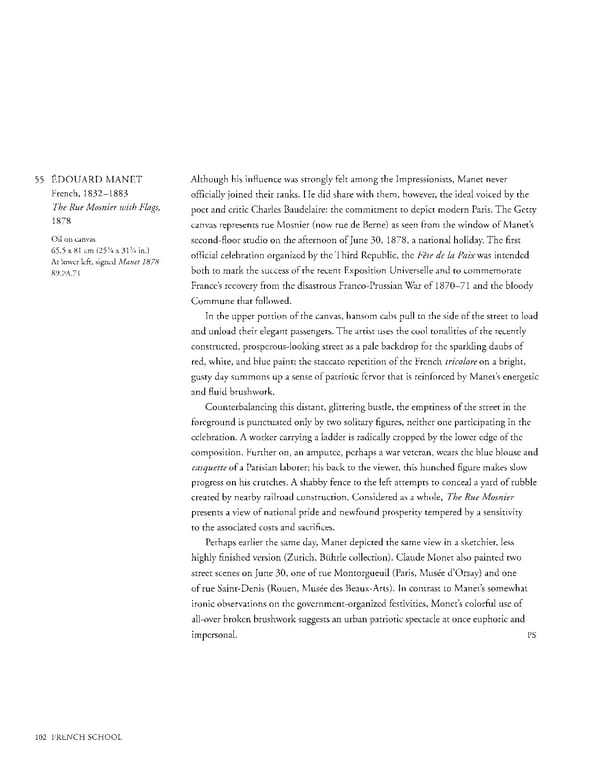55 EDOUARD MANET Although his influence was strongly felt among the Impressionists, Manet never French, 1832-1883 officially joined their ranks. He did share with them, however, the ideal voiced by the The Rue Mosnier with Flags, poet and critic Charles Baudelaire: the commitment to depict modern Paris. The Getty 1878 canvas represents rue Mosnier (now rue de Berne) as seen from the window of Manet's Oil on canvas second-floor studio on the afternoon of June 30, 1878, a national holiday. The first 65.5 x 81 cm (25¾ x 31¾ in.) official celebration organized by the Third Republic, the Fete de la Paix was intended At lower left, signed Manet 1878 89.PA.71 both to mark the success of the recent Exposition Universelle and to commemorate France's recovery from the disastrous Franco-Prussian War of 1870-71 and the bloody Commune that followed. In the upper portion of the canvas, hansom cabs pull to the side of the street to load and unload their elegant passengers. The artist uses the cool tonalities of the recently constructed, prosperous-looking street as a pale backdrop for the sparkling daubs of red, white, and blue paint; the staccato repetition of the French tricolore on a bright, gusty day summons up a sense of patriotic fervor that is reinforced by Manet's energetic and fluid brushwork. Counterbalancing this distant, glittering bustle, the emptiness of the street in the foreground is punctuated only by two solitary figures, neither one participating in the celebration. A worker carrying a ladder is radically cropped by the lower edge of the composition. Further on, an amputee, perhaps a war veteran, wears the blue blouse and casquette of a Parisian laborer; his back to the viewer, this hunched figure makes slow progress on his crutches. A shabby fence to the left attempts to conceal a yard of rubble created by nearby railroad construction. Considered as a whole, The Rue Mosnier presents a view of national pride and newfound prosperity tempered by a sensitivity to the associated costs and sacrifices. Perhaps earlier the same day, Manet depicted the same view in a sketchier, less highly finished version (Zurich, Buhrle collection). Claude Monet also painted two street scenes on June 30, one of rue Montorgueuil (Paris, Musee d'Orsay) and one of rue Saint-Denis (Rouen, Musee des Beaux-Arts). In contrast to Manet's somewhat ironic observations on the government-organized festivities, Monet's colorful use of all-over broken brushwork suggests an urban patriotic spectacle at once euphoric and impersonal. PS 102 FRENCH SCHOOL
 Masterpieces of the Getty Museum: Paintings Page 102 Page 104
Masterpieces of the Getty Museum: Paintings Page 102 Page 104